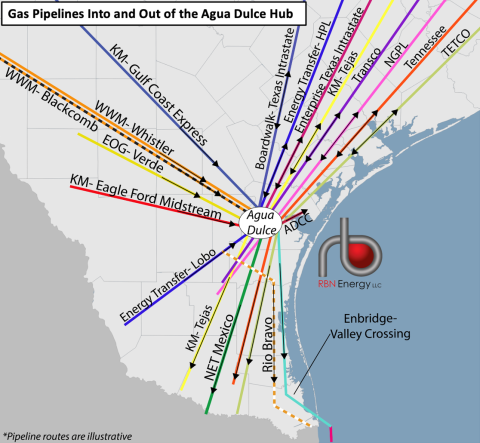There may be ongoing uncertainty about the timing and volumes, but it’s not difficult to anticipate that natural gas flows through the Agua Dulce Hub near Corpus Christi will be rising significantly over the next few years as new LNG export capacity starts up and new gas-fired power plants come online in South Texas and south of the border in Mexico. In today’s RBN blog, we discuss the status of the pipelines under development to transport gas into and out of Agua Dulce and the LNG facilities and power plants being planned and built to receive that gas. We’ll also look at our forecast for pipeline-corridor flows in the Agua Dulce area.
We’ll begin with a brief recap of what we’ve said in recent blogs about the Agua Dulce Hub and why it’s been becoming an increasingly important crossroads for gas. As we said in Part 1 of this series, more than a dozen pipelines flow into the hub (see Figure 1 below) — five (soon to be six) from the Permian and Eagle Ford production areas and eight bidirectional pipelines along the Gulf Coast. The former group includes well-known giants like Gulf Coast Express (GCX), Whistler, and the planned Blackcomb pipelines as well as the Verde, Eagle Ford Midstream and Lobo systems. The latter group, in turn, includes decades-old mega-systems like Transco, Tennessee Gas Pipeline (TGP), TETCO and NGPL, plus Enterprise’s, Energy Transfer’s and Boardwalk’s Texas intrastate pipelines and the Houston Pipeline System (HPL).
As for the pipelines flowing gas out of the Agua Dulce area, these include (of course) the bidirectional coastal pipelines noted above that can flow north from the hub (TGP, TETCO, NGPL, etc.) as well as the new 1.7-Bcf/d ADCC Pipeline, which (as its acronym suggests) runs from Agua Dulce to Corpus Christi. Then there are the handful of pipes that run south out of Agua Dulce to (or at least toward) the Texas/Mexico border. These include the southern tips of five aforementioned coastal systems — Kinder Morgan’s Tejas intrastate pipe, Transco, NGPL, TGP and TETCO — plus Kinder’s NET Mexico Pipeline, which runs to the Rio Grande, where it connects to the Los Ramones pipeline in Mexico; and Enbridge’s Valley Crossing pipeline, which connects at the border to the Sur de Texas-Tuxpan Pipeline in Mexico.
In addition to these, there’s the planned Rio Bravo pipeline — actually a pair of pipes with a combined capacity of 4.5 Bcf/d — that will run from near Agua Dulce to NextDecade Corp.’s Rio Grande LNG export facility. (More on these later.)
Figure 1. Gas Pipelines Into and Out of the Agua Dulce Hub. Source: RBN
Join Backstage Pass to Read Full Article








